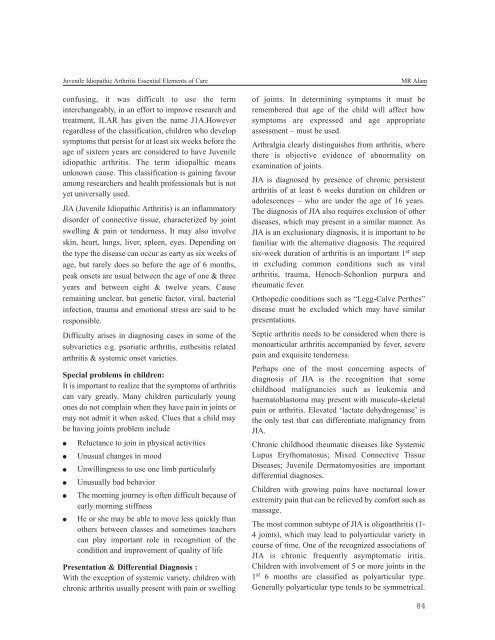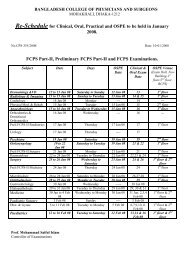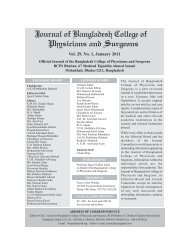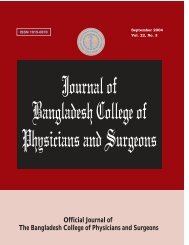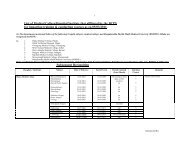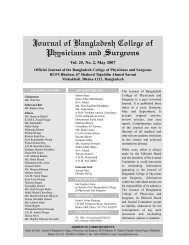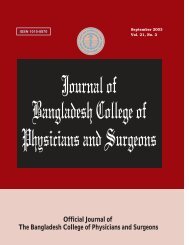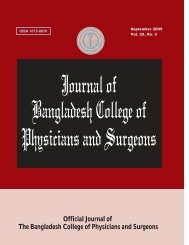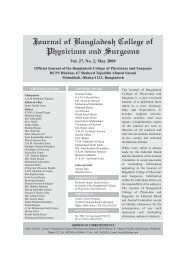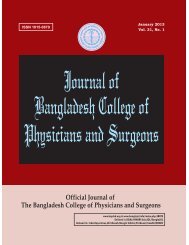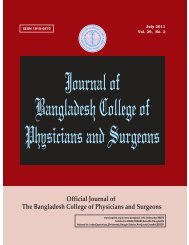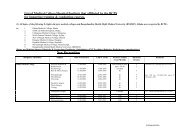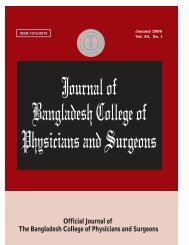May 2008 - bcps
May 2008 - bcps
May 2008 - bcps
You also want an ePaper? Increase the reach of your titles
YUMPU automatically turns print PDFs into web optimized ePapers that Google loves.
Juvenile Idiopathic Arthritis Essential Elements of Careconfusing, it was difficult to use the terminterchangeably, in an effort to improve research andtreatment, ILAR has given the name J1A.Howeverregardless of the classification, children who developsymptoms that persist for at least six weeks before theage of sixteen years are considered to have Juvenileidiopathic arthritis. The term idiopalhic meansunknown cause. This classification is gaining favouramong researchers and health professionals but is notyet universally used.JlA (Juvenile Idiopathic Arthritis) is an inflammatorydisorder of connective tissue, characterized by jointswelling & pain or tenderness. It may also involveskin, heart, lungs, liver, spleen, eyes. Depending onthe type the disease can occur as earty as six weeks ofage, but rarely does so before the age of 6 months,peak onsets are usual between the age of one & threeyears and between eight & twelve years. Causeremaining unclear, but genetic factor, viral, bacterialinfection, trauma and emotional stress are said to beresponsible.Difficulty arises in diagnosing cases in some of thesubvarieties e.g. psoriatic arthritis, enthesitis relatedarthritis & systemic onset varieties.Special problems in children:It is important to realize that the symptoms of arthritiscan vary greatly. Many children particularly youngones do not complain when they have pain in joints ormay not admit it when asked. Clues that a child maybe having joints problem include●●●●●●Reluctance to join in physical activitiesUnusual changes in moodUnwillingness to use one limb particularlyUnusually bad behaviorThe morning journey is often difficult because ofearly morning stiffnessHe or she may be able to move less quickly thanothers between classes and sometimes teacherscan play important role in recognition of thecondition and improvement of quality of lifePresentation & Differential Diagnosis :With the exception of systemic variety, children withchronic arthritis usually present with pain or swellingMR Alamof joints. In determining symptoms it must beremembered that age of the child will affect howsymptoms are expressed and age appropriateassessment – must be used.Arthralgia clearly distinguishes from arthritis, wherethere is objective evidence of abnormality onexamination of joints.JIA is diagnosed by presence of chronic persistentarthritis of at least 6 weeks duration on children oradolescences – who are under the age of 16 years.The diagnosis of JIA also requires exclusion of otherdiseases, which may present in a similar manner. AsJIA is an exclusionary diagnosis, it is important to befamiliar with the alternative diagnosis. The requiredsix-week duration of arthritis is an important 1 st stepin excluding common conditions such as viralarthritis, trauma, Henoch-Schonlion purpura andrheumatic fever.Orthopedic conditions such as “Legg-Calve Perthes”disease must be excluded which may have similarpresentations.Septic arthritis needs to be considered when there ismonoarticular arthritis accompanied by fever, severepain and exquisite tenderness.Perhaps one of the most concerning aspects ofdiagnosis of JIA is the recognition that somechildhood malignancies such as leukemia andhaematoblastoma may present with musculo-skeletalpain or arthritis. Elevated ‘lactate dehydrogenase’ isthe only test that can differentiate malignancy fromJIA.Chronic childhood rheumatic diseases like SystemicLupus Erythomatosus; Mixed Connective TissueDiseases; Juvenile Dermatomyosities are importantdifferential diagnoses.Children with growing pains have nocturnal lowerextremity pain that can be relieved by comfort such asmassage.The most common subtype of JIA is oligoarthritis (1-4 joints), which may lead to polyarticular variety incourse of time. One of the recognized associations ofJIA is chronic frequently asymptomatic iritis.Children with involvement of 5 or more joints in the1 st 6 months are classified as polyarticular type.Generally polyarticular type tends to be symmetrical.84


